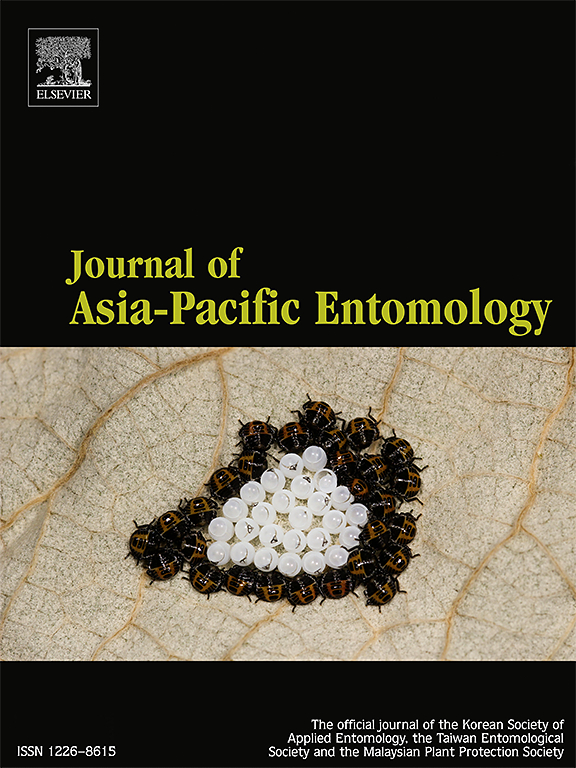Insecticidal and antibacterial properties of zinc oxide nanoparticles (ZnO-NPs) synthesized from Phoebe zhennan leaf extract
IF 1.3
3区 农林科学
Q3 ENTOMOLOGY
引用次数: 0
Abstract
Chemical insecticides are used to control most insect pests, which are harmful to the environment and humans. In this study, green synthesis of zinc oxide nanoparticles (ZnO-NPs) was carried out by using extracts from the Phoebe zhennan plant leaf. X-ray diffraction, transmission electron microscopy (TEM), scanning electron microscopy (SEM), ultraviolet–visible spectroscopy, and Fourier transform infrared spectroscopy (FTIR) confirmed the successful synthesis and structural characteristics of nanoparticles. The forest insect pest Plagiodera versicolora Laicharting is used to evaluate the bioactivity of nanoparticles. Mortality in P. versicolora was found to be dose- and time-dependent after different treatments of nanoparticles. The study determined the lethal concentration values (LC50 and LC90) of nanoparticles against P. versicolora, revealing a time-dependent efficacy with the LC50 of 22.47 mg/L and LC90 of 81.2 mg/L at 96 h. The findings revealed the lethal time values (LT50 and LT90) of the nanoparticles against P. versicolora, with maximum efficacy observed at a concentration of 50 mg/L, resulting in an LT50 of 27.24 h and an LT90 of 62.71 h. In addition, the antibacterial activity of nanoparticles was also evaluated against Bacillus subtilis, and the results showed significant inhibition of bacterial growth in a dose-dependent manner. The study demonstrated the potential of nanoparticles as an insect control and antimicrobial agent. This research provides valuable insights into the green synthesis of nanoparticles and emphasizes the need for further exploration of their safety and efficacy in various practical applications.

竹叶提取物合成氧化锌纳米粒子的杀虫抑菌性能
化学杀虫剂用于控制大多数对环境和人类有害的害虫。本研究以真南叶提取物为原料,进行了氧化锌纳米颗粒(ZnO-NPs)的绿色合成。x射线衍射、透射电子显微镜(TEM)、扫描电子显微镜(SEM)、紫外可见光谱和傅里叶变换红外光谱(FTIR)证实了纳米颗粒的成功合成和结构特征。利用森林害虫花斑曲蝗(Plagiodera versicolora Laicharting)对纳米颗粒的生物活性进行了评价。在不同的纳米颗粒处理后,发现斑孢霉的死亡率与剂量和时间有关。实验测定了纳米颗粒对紫斑拟虫的致死浓度(LC50和LC90), 96 h时LC50和LC90分别为22.47 mg/L和81.2 mg/L,具有时间依赖性。结果表明,纳米颗粒对紫斑拟虫的致死时间(LT50和LT90)在浓度为50 mg/L时达到最大,LT50和LT90分别为27.24 h和62.71 h。纳米颗粒对枯草芽孢杆菌的抑菌活性也进行了评估,结果表明纳米颗粒对枯草芽孢杆菌的生长有明显的抑制作用,且呈剂量依赖性。该研究证明了纳米颗粒作为昆虫控制和抗菌剂的潜力。本研究为纳米颗粒的绿色合成提供了有价值的见解,并强调了在各种实际应用中进一步探索其安全性和有效性的必要性。
本文章由计算机程序翻译,如有差异,请以英文原文为准。
求助全文
约1分钟内获得全文
求助全文
来源期刊

Journal of Asia-pacific Entomology
Agricultural and Biological Sciences-Insect Science
CiteScore
2.70
自引率
6.70%
发文量
152
审稿时长
69 days
期刊介绍:
The journal publishes original research papers, review articles and short communications in the basic and applied area concerning insects, mites or other arthropods and nematodes of economic importance in agriculture, forestry, industry, human and animal health, and natural resource and environment management, and is the official journal of the Korean Society of Applied Entomology and the Taiwan Entomological Society.
 求助内容:
求助内容: 应助结果提醒方式:
应助结果提醒方式:


